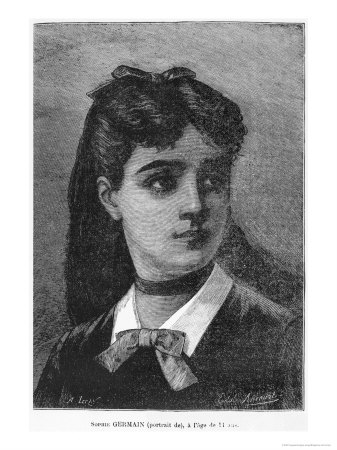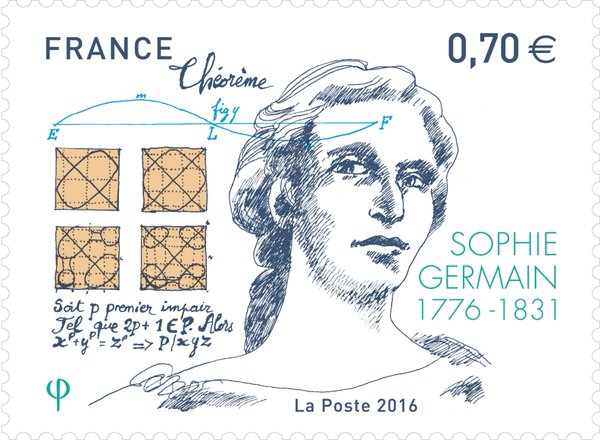Meet Sophie Germain, the amateur mathematician who worked on number theory's toughest problem
Germain, or "Monsieur LeBlanc" to her professors, took a bold and creative approach to life and math
Brittney G. Borowiec
Born in Paris in 1776, Sophie Germain's teenage years were spent witnessing the French revolution. Her father, a silk-merchant, had a library and Germain tried to distract herself from the volatile political and social situation by reading some of his books. One of those books was the story of Archimedes, who was so captivated by the mathematics he was working on that he did not notice the invading Roman soldier who swiftly killed him. Looking for an intellectual escape, how could Germain not be curious about the subject that distracted a man to death?
Unfortunately for Germain, mathematics was not regarded as a suitable subject for women in her time so she studied in secret, at night. When her parents discovered her night time study habit, they took away her fire, light, and even her clothes in an attempt to get her to stop studying and stay in bed. When even this failed, they relented. That did not mean she could study mathematics freely, however. Classes at the École centrale des travaux publics, later known as the École Polytechnique, were only available to men, but 18 year old Germain was able to obtain lecture notes for some of the classes. She then assumed the name of a male student, Monsieur LeBlanc, and wrote to one of the professors, Joseph-Louis Lagrange. Lagrange was impressed with Monsieur LeBlanc’s abilities and remained supportive when he found out LeBlanc was actually a woman.

Sophie Germain at 14 years of age.
Later, in 1804, Germain used the pseudonym Monsieur LeBlanc to write to another top mathematician: Carl Friedrich Gauss. Like Lagrange, Gauss was impressed with LeBlanc's abilities and they corresponded for a number of years. Germain eventually revealed her true identity to Gauss after Napoleon's 1806 invasion of Gauss's hometown. Once she learned of the invasion, Germain worried Gauss would meet the same fate as Archimedes and asked her friend General Pernety to protect him. Fortunately Gauss was safe, but when a French officer checked on him, explaining that a Parisian woman named Sophie Germain was concerned for his safety, he was confused as he did not know who she was. When this was reported back to Germain, she wrote to Gauss explaining the situation, revealing her true identity in the process. Fortunately, Gauss reacted positively to the news that LeBlanc was really Germain, telling her that women who overcome society’s prejudices to do mathematics have “the most noble courage, extraordinary talent, and superior genius."
During their correspondence, Germain and Gauss discussed their shared interest in number theory. Number theory is the branch of mathematics concerned with whole numbers and especially prime numbers. One of the most intriguing claims in number theory at the time was Fermat's Last Theorem: the equation xn+ yn = zn , called the Fermat equation, has no positive whole number solutions for any whole number n>2 (so, for instance, 32 + 42 = 52 works great, but no such equation exists for any exponent greater than two). It got its name from amateur mathematician Pierre de Fermat claiming he had a proof of it in around 1630, though he died without writing it down (and given what we know now it is very unlikely his "proof" was correct). Although Fermat’s Last Theorem is relatively simple to state, it wasn't proven for another two centuries after Germain and Gauss, in 1995 by Andrew Wiles with help from Richard Taylor.
.jpg)
National Library of France via Wikimedia Commons
Germain wrote to Gauss about Fermat’s Last Theorem on multiple occasions. In fact, she described some of her early attempts to prove it in her very first letter to him in 1804. In 1809, however, the French Academy of Sciences announced a prize competition to mathematically explain the behavior of vibrating surfaces, causing Germain to switch her focus to applied mathematics. She worked on this topic for a number of years and in 1816 was awarded the gold medal, making her the first woman to win a prize from the French Academy of Sciences. That same year, the Academy announced a new prize competition to prove Fermat’s Last Theorem and Germain began working on it again.
By the time the competition was announced, mathematicians had made some limited progress towards proving Fermat's Last Theorem. They could prove that it held for exponents n=3 and n=4, i.e. they could show that there were no positive whole number solutions to the equations x3 + y3 = z3 and x4 + y4 = z4. They also knew that proving Fermat’s Last Theorem for all prime numbers greater than 2, i.e. showing that xp + yp = zp has no solutions for p>2, was enough to prove Fermat’s Last Theorem in its entirety. To make further progress, however, they had to go beyond proving the result for specific exponents like 3 and 4. Germain did exactly this by proving, as mathematician and Germain biographer Dora Musielak describes it, "the first general result about arbitrary exponents for FLT [Fermat's Last Theorem]." This result is now known as Sophie Germain’s Theorem.

Stamp of Sophie Germain issued by France in 2016
Sophie Germain's Theorem is quite technical, so let's focus on a simpler special case. First, there are Sophie Germain primes. A prime p is called a Sophie Germain prime if 2p+1 is also prime. So, for example, 3 is a Sophie Germain prime since 2 times 3 plus 1 is 7, which is also prime. 7, however, is not a Sophie Germain prime as 2 times 7 plus 1 is 15, which is not prime. As well as appearing in her work on Fermat's Last Theorem, Sophie Germain primes have important applications in cryptography, the mathematical study of codes and code-breaking.
The special case of Germain's Theorem says that for any Sophie Germain prime p>2, the equation xp + yp = zp has no solutions when x times y times z is not divisible by p. This rules out a class of potential solutions to the Fermat equation when the exponent is a Sophie Germain prime. Germain also used the full version of her Theorem to show that for any prime p (not just Sophie Germain primes) greater than 2 and less than 100, the equation xp + yp = zp has no solutions when x*y*z is not divisible by p.
Until around 2008, historians of mathematics thought that, while impressive and significant, Germain’s Theorem was her only contribution to Fermat’s Last Theorem. Then Andrea Del Centina and Reinhard Laubenbacher and David Pengelley examined her unpublished papers and discovered that Germain’s Theorem was just one piece of a much larger and sophisticated plan she had developed to prove all of Fermat’s Last Theorem. Her general idea was to show that any solutions to the equation xp + yp = zp must have infinitely many prime divisors. This would mean that there cannot be any solutions, because any number divisible by infinitely many primes must itself be infinite. Unfortunately, her plan could not be made to work, as she herself came to recognize. Nonetheless, it was still fruitful. In her pursuit of it, Germain developed new methods and proved new results that were later rediscovered by others.
Despite Germain's brilliance, the continual obstacles she faced due to her gender made it impossible for her to become a professional mathematician. She thus remained an amateur throughout her life, never obtaining a position at a university. Her mathematical work, however, was sophisticated and exemplified her boldness and creativity, just like her earlier efforts to overcome barriers to gain a mathematical education.
Musielak suggested in an email interview that the obstacles Germain faced may have even shaped her approach to Fermat's Last Theorem: "Maybe because she was an amateur mathematician, determined to arrive at a proof, working alone with all odds against her, Germain had to think differently. In the end, Sophie Germain developed her own algorithms and a unique approach to prove Fermat's theorem, distinctively different from Euler’s and Fermat's."